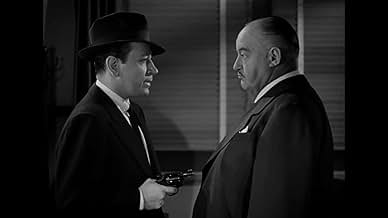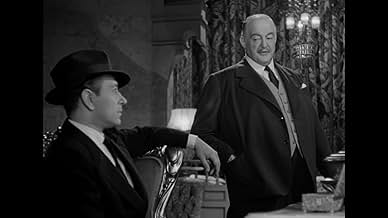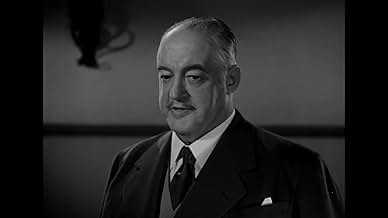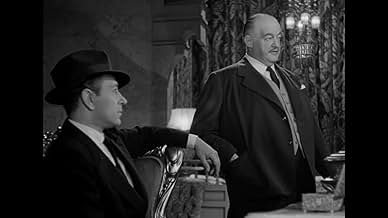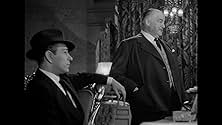IMDb RATING
6.4/10
1.8K
YOUR RATING
A German spy ring plans to publicize a false rumor that Russia, who is fighting Germany, plans to invade neutral Turkey in order to ally them with the Nazis.A German spy ring plans to publicize a false rumor that Russia, who is fighting Germany, plans to invade neutral Turkey in order to ally them with the Nazis.A German spy ring plans to publicize a false rumor that Russia, who is fighting Germany, plans to invade neutral Turkey in order to ally them with the Nazis.
Rafael Alcayde
- Turkish Husband on Train
- (uncredited)
Nino Bellini
- Turkish Secretary
- (uncredited)
Eumenio Blanco
- Syrian Vendor
- (uncredited)
John Bleifer
- Secretary
- (uncredited)
Walter Bonn
- German Officer
- (uncredited)
Dick Botiller
- Plane Announcer
- (uncredited)
Mary Chan
- Club Patron
- (uncredited)
Jack Chefe
- Elevator Operator
- (uncredited)
Pedro de Cordoba
- Baba
- (uncredited)
Jean De Briac
- Levantine Porter
- (uncredited)
Featured reviews
Nicely paced WW2 spy thriller with George Raft playing an American agent trying to stop a German plan to turn Turkey against Russia. It's an ill-fitting role for Raft but I can't say he was terrible. I always liked him, even if he could be a pretty wooden actor sometimes. This is the kind of role I could easily see Bogart playing, which is ironic considering George Raft notoriously turned down some of the parts that made Bogart's career, such as Maltese Falcon and Casablanca. This movie also marked the end of Raft's contract with Warner Bros, which effectively meant the beginning of the end of his days as an A-lister.
The fairly short runtime helps, as does the great supporting cast. Peter Lorre and Sydney Greenstreet are always worth watching. Lovely Brenda Marshall and Ona Massen are good, too. Perhaps I'm in the minority, but I thought this was a very enjoyable movie of its type. I'm sure if you dislike Raft you will find it tougher going than I did. If you're a fan of the cast or WW2 movies in general, I definitely recommend you try this one out.
The fairly short runtime helps, as does the great supporting cast. Peter Lorre and Sydney Greenstreet are always worth watching. Lovely Brenda Marshall and Ona Massen are good, too. Perhaps I'm in the minority, but I thought this was a very enjoyable movie of its type. I'm sure if you dislike Raft you will find it tougher going than I did. If you're a fan of the cast or WW2 movies in general, I definitely recommend you try this one out.
I liked this film although there were certainly many better for the time. It is the usual war time movie without being too much like the rest.
How can you go wrong watching Sidney Greenstreet and Peter Lorre together? Greenstreet is simply magnetic, and I was stunned to find out he debuted in films with Casablanca only a year before.
I kept thinking during the movie how much better it would have been with someone else besides Raft in the title role, he is pretty wooden. I am not sure where his performance ranks with his other roles. I hope they were better but doubt that they were. I don't watch many of them normally.
Brenda Marshall provides window dressing mostly and the ending smacks of a cheap knockoff attempt, but the rest wasn't too bad.
How can you go wrong watching Sidney Greenstreet and Peter Lorre together? Greenstreet is simply magnetic, and I was stunned to find out he debuted in films with Casablanca only a year before.
I kept thinking during the movie how much better it would have been with someone else besides Raft in the title role, he is pretty wooden. I am not sure where his performance ranks with his other roles. I hope they were better but doubt that they were. I don't watch many of them normally.
Brenda Marshall provides window dressing mostly and the ending smacks of a cheap knockoff attempt, but the rest wasn't too bad.
Yes, it's definitely not a work of art. It doesn't spend much time on character development. However, it moves very fast, never staying in one place for too long. Some good action sequences and scenes on a fast moving train, hotel rooms, in a German headquarters, etc. make this a fun film. The acting is not at all bad despite what you may have read elsewhere. Of course, Sidney Greenstreet plays his usual pompous rearend character that seems to be his one and only characterization but, he pulls it off well, causing the audience to dislike him appropriately. Peter Lorre obviously had fun with his role and George Raft was much better than I expected. Turhan Bey did a great job and his character was very welcomed indeed. All in all, if the viewers don't expect this movie to be the second coming of Casablanca and just sit back and watch the action, they will be rewarded with approximately 80 minutes of a suspenseful and fun movie.
Background to Danger (1943)
On the uncertain fringes of the European War are countries like Morocco, Syria, and Turkey, where the intrigues of diplomats and expatriates can become complicated and colorful, several movies were made about WWII. One of those, obviously, is "Casablanca," released to full distribution in 1943. And in this one we have Peter Lorre (as a shadowy character of course), Sydney Greenstreet (as a Nazi leader), and Bogart-wannabe George Raft, who takes the leading role.
Unlike Casablanca, however, this one, set in Syria and Turkey, is filled with action, chasing, fear, and trickery. The shadows are not glamorous and romantic, but dangerous. It's a Warner crime film adapted to the war. Raft plays an American archetype a little like Bogart would have, independent and a little sassy, though he is always more eager to be liked, both by the other characters and the audience.
Director Raoul Walsh is one of the greats of early Hollywood (he even assisted Griffith on "Birth of a Nation"). He makes this story intense, fluid, dramatic, and physical in the best ways. In particular, the huge range of sets and scenes (almost entirely on the studio lot) is impressive and effective. The camera moves, the light is harsh when it isn't pure shadow, and music swells and twirls, and most of all the characters are always on the movie.
The kinetic essence of the whole enterprise is in keeping with the first scary years of the real war, and that's on every audience member's mind. Unlike "Casablanca," set in the days before Pearl Harbor (though filmed after), this movie was planned and shot as the U.S. was already sending troops to Europe. The message here is clearly anti-Nazi, and desperate. Lorre is duplicitous and fabulous in his large role. The leading woman, Brenda Marshall, is no Ingrid Bergman, nor quite an effective action figure.
"I'm American. America's at war," Raft's character says halfway through. And Lorre lays out for him some of the complications of the real war, and how Russia is an ally with complicated intentions. And in a slightly opportunistic way, the movie makes clear that Russia (which is rarely called the Soviet Union, its real name) is a friend. It becomes clearer and clearer as it goes, until the last line of the movie nails it down.
A great movie this is not, but it's actually really good, worth seeing, a thrilling ride even if you have to swallow the kind of facile way the plot is kept intact at times. You can almost watch it for ambiance alone, as cinematographer Tony Gaudio pulls out the stops in the same way (visually) he famously did for Wyler in "The Letter." What Raft lacks in intensity Lorre makes up for in brilliance. Give it a chance.
On the uncertain fringes of the European War are countries like Morocco, Syria, and Turkey, where the intrigues of diplomats and expatriates can become complicated and colorful, several movies were made about WWII. One of those, obviously, is "Casablanca," released to full distribution in 1943. And in this one we have Peter Lorre (as a shadowy character of course), Sydney Greenstreet (as a Nazi leader), and Bogart-wannabe George Raft, who takes the leading role.
Unlike Casablanca, however, this one, set in Syria and Turkey, is filled with action, chasing, fear, and trickery. The shadows are not glamorous and romantic, but dangerous. It's a Warner crime film adapted to the war. Raft plays an American archetype a little like Bogart would have, independent and a little sassy, though he is always more eager to be liked, both by the other characters and the audience.
Director Raoul Walsh is one of the greats of early Hollywood (he even assisted Griffith on "Birth of a Nation"). He makes this story intense, fluid, dramatic, and physical in the best ways. In particular, the huge range of sets and scenes (almost entirely on the studio lot) is impressive and effective. The camera moves, the light is harsh when it isn't pure shadow, and music swells and twirls, and most of all the characters are always on the movie.
The kinetic essence of the whole enterprise is in keeping with the first scary years of the real war, and that's on every audience member's mind. Unlike "Casablanca," set in the days before Pearl Harbor (though filmed after), this movie was planned and shot as the U.S. was already sending troops to Europe. The message here is clearly anti-Nazi, and desperate. Lorre is duplicitous and fabulous in his large role. The leading woman, Brenda Marshall, is no Ingrid Bergman, nor quite an effective action figure.
"I'm American. America's at war," Raft's character says halfway through. And Lorre lays out for him some of the complications of the real war, and how Russia is an ally with complicated intentions. And in a slightly opportunistic way, the movie makes clear that Russia (which is rarely called the Soviet Union, its real name) is a friend. It becomes clearer and clearer as it goes, until the last line of the movie nails it down.
A great movie this is not, but it's actually really good, worth seeing, a thrilling ride even if you have to swallow the kind of facile way the plot is kept intact at times. You can almost watch it for ambiance alone, as cinematographer Tony Gaudio pulls out the stops in the same way (visually) he famously did for Wyler in "The Letter." What Raft lacks in intensity Lorre makes up for in brilliance. Give it a chance.
During the Second World War years, Hollywood found in the European-intrigue novels of Eric Ambler a pliable resource for converting into thrillers that beat drums for the anti-Axis cause. So, like tanks off an assembly line, rolled Journey into Fear (1942), Background to Danger (1943) and The Mask of Dimitrios (1944). They benefitted from name directors respectively, Orson Welles (at least in part), Raoul Walsh and Jean Negulesco but none of them is particularly remarkable; they're not much more than shortish propaganda programmers.
Background to Danger reunites the sinister but winning Warner Bros. team of Sydney Greenstreet and Peter Lorre, but, instead of the expected Humphrey Bogart as plucky hero, plunks George Raft down in a strange land, this time Turkey, strategically situated at the convergence of the Middle East, the Balkans and the Soviet Union. The plot involves forged maps which Nazi agent Greenstreet hopes to use to foment a panic about plans to invade Turkey by the U.S.S.R., then an Ally, hence destabilizing the region and the balance of power. But Walsh forgoes the depth that a geopolitical perspective might have lent in favor of bombs and handguns, captures and hair's-breadth escapes.
Raft's wooden affect sometimes paid off in the noir cycle (Noctune, Red Light) but here his gaudy patter only makes viewers wish for Bogart. And while Greenstreet reprises his polished, blustering heavy, Lorre gives a droll, airy performance that verges on the comic (clearly, unlike his Gargantuan partner, he didn't take to type-casting). Raft's love interest, playing Lorre's sister, is Brenda Marshall, a.k.a. Mrs. William Holden or Ardis Ankerson, by all accounts a difficult woman but, judging by Strange Impersonation and her few other movies, not a negligible presence. Turhan Bey shows up as Raft's native sidekick, à la From Russia With Love. He brings a final touch of authenticity to the back-lot Ankara and Istanbul, which Walsh, to his credit, takes care to make more vivid than just generically exotic.
Background to Danger reunites the sinister but winning Warner Bros. team of Sydney Greenstreet and Peter Lorre, but, instead of the expected Humphrey Bogart as plucky hero, plunks George Raft down in a strange land, this time Turkey, strategically situated at the convergence of the Middle East, the Balkans and the Soviet Union. The plot involves forged maps which Nazi agent Greenstreet hopes to use to foment a panic about plans to invade Turkey by the U.S.S.R., then an Ally, hence destabilizing the region and the balance of power. But Walsh forgoes the depth that a geopolitical perspective might have lent in favor of bombs and handguns, captures and hair's-breadth escapes.
Raft's wooden affect sometimes paid off in the noir cycle (Noctune, Red Light) but here his gaudy patter only makes viewers wish for Bogart. And while Greenstreet reprises his polished, blustering heavy, Lorre gives a droll, airy performance that verges on the comic (clearly, unlike his Gargantuan partner, he didn't take to type-casting). Raft's love interest, playing Lorre's sister, is Brenda Marshall, a.k.a. Mrs. William Holden or Ardis Ankerson, by all accounts a difficult woman but, judging by Strange Impersonation and her few other movies, not a negligible presence. Turhan Bey shows up as Raft's native sidekick, à la From Russia With Love. He brings a final touch of authenticity to the back-lot Ankara and Istanbul, which Walsh, to his credit, takes care to make more vivid than just generically exotic.
Did you know
- TriviaThere was an assassination attempt on German ambassador Franz von Papen as depicted in this film. It occurred on February 24, 1942 and was carried out by the Soviet NKVD. However, in reality, the bomb malfunctioned and killed the would-be assassin - he did not get away by car as shown in this film.
- GoofsWhen the train is shown leaving Ankara Station for Istanbul (48 minutes in) you see a bit of stock footage showing a (British) Southern Railway class M7 suburban tank engine running somewhere on the South Eastern and Chatham system which runs between London and Kent.
- Quotes
Nikolai Zaleshoff: How did you know the gun wasn't loaded?
Joe Barton: By its weight.
Nikolai Zaleshoff: There might have been one bullet in it.
Joe Barton: That's the chance I had to take.
Nikolai Zaleshoff: YOU had to take?
- ConnectionsFeatured in Warner at War (2008)
- How long is Background to Danger?Powered by Alexa
Details
- Release date
- Country of origin
- Languages
- Also known as
- El expreso Bagdad-Estambul
- Filming locations
- Estressin, Vienne, Isère, France(second crew or archive shot of train station at the Syria-Turkey border)
- Production company
- See more company credits at IMDbPro
- Runtime
- 1h 20m(80 min)
- Color
- Aspect ratio
- 1.37 : 1
Contribute to this page
Suggest an edit or add missing content



